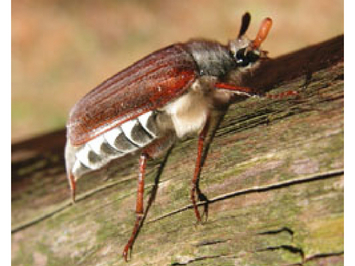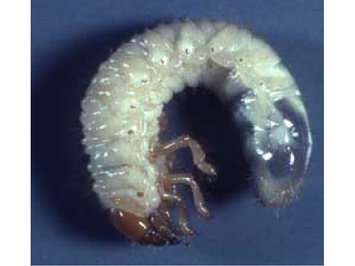Cockchafer
Melolontha spp.
Appearance


The beetles grow to about 30 mm long and show different color variations. While the majority shows a dark head, a dark neck shield and chestnut-brown elytra, there are also very dark, completely reddish-brown as well as light-colored specimens.
May beetle larvae (grubs) have a dark head capsule and jointed legs. They are characterized by their rear end bent forward in a U-shape.
Biology
Cockchafers belong to theScarabaeidae family, which also includes the rose chafer, dung beetle and rhinoceros beetle. There are three different species of cockchafer in Central Europe: the more common field cockchafer(Melolontha melolontha), the rarer forest cockchafer(Melolontha hippocastani) and the only sporadically occurring Melolontha pectoralis. The forest cockchafer is also found in Scandinavia and Siberia, while the field cockchafer is mainly found in Central Europe. All three species look very similar to each other and their distribution areas overlap to some extent, so they are treated together here.
The grubs are the characteristic larval form for the entire group of leaf-horned beetles and the stag beetle relatives. Other common larvae known as "grubs" are those of the June beetle (Amphimallon solstitiale), which are particularly harmful in lawns, and the grubs of rose chafer beetles (Cetoniinae) living in compost heaps, which are usually not harmful. In contrast, the particularly large grubs of stag beetles (Lucanus cervus) and rhinoceros beetles (Oryctes nasicornis) can be found in decaying tree trunks. The latter forms are not pests or are even protected and must be protected at all costs.
Mass occurrence
The most striking characteristic of cockchafers is their annual mass occurrence. In the course of this, forest trees, vines, fruit trees and ornamental trees can be completely eaten bare. Swarming is conspicuous during the evening hours on forest edges or prominent individual trees. Here the beetles carry out a maturation feeding and mate. After mating, the mated females return to the place where they spent their larval life to lay their eggs. To do this, they must first burrow into the ground to a depth of around 25 cm.
Development period
Overall development takes several years and is highly dependent on the prevailing soil temperatures. In cooler areas, development takes four years, in warmer areas it is completed after just three years. This means that, depending on the region, a strong flight can be expected every three or four years. This predominance of certain flight years varies from region to region.
Egg laying and hatching of the larvae
The female cockchafer lays about 30 cream-coloured eggs, which are about 3 mm in size. The depth of the soil reached when the eggs are laid depends greatly on the soil structure. After laying their eggs, female cockchafer beetles return to their swarm trees to mate again and lay eggs. The grubs hatch after about a month.
The young grubs initially live on finer fibrous roots. As their body size increases, they turn more and more towards the stronger roots of their host plants. In the course of their lives, they moult several times, so that three larval stages of different sizes can be distinguished. Damage depends, among other factors, on the age of the beetle larvae and is therefore most significant in the year following the flight. Depending on the season, grubs live at different soil depths: while they live in shallow soil layers up to 20 cm deep during the growing season, they spend the cold season up to 60 cm deep in order to avoid low temperatures. In late summer, before the year of flight, the old larvae, now already measuring 4 cm, create a small cavity at a depth of around 40 cm in the soil, where they can pupate undisturbed. Three weeks later, the finished beetle emerges, but remains in the soil, where it hibernates and only emerges to the surface when the soil temperatures rise the following spring.
Host plants
The adult cockchafer feeds on a wide variety of deciduous trees and shrubs such as: Oak, maple, beech, stone fruit, walnut, larch, vine and hazelnut.
The larvae feed on the roots of various fruit trees, forest trees, vine, clover, horn clover, dandelion and other meadow herbs and grasses.
Distribution
Already about 100 years ago, the first large-scale survey on the flight of the cockchafer was started in Austria. At that time, attempts were made to predict the mass flight in order to be able to take countermeasures in time. Today, moreover, the connection with changed climatic conditions is the focus of interest. Due to the regular development cycle of the cockchafer, it is possible to predict quite well in which regions of Austria an occurrence of cockchafer is to be expected.
In geographical maps, those areas are marked in color where flight of cockchafer is to be expected due to long-term cycles of cockchafer development. Red dots indicate actually observed strong flight. Depending on the average temperature, May beetles take three or four years to develop from egg to finished beetle. In the wake of particularly warm or cool years, however, the beetles may hatch a year earlier or later than anticipated in some areas. This new flight periodicity is then maintained in the future until climatic conditions change again. In this way, cockchafer beetles are a good indicator of changes in climate patterns.
Prevention and control
- Collecting the beetles by hand.
- Some of the grubs are destroyed by tilling the soil. This method is only effective as long as the grubs are not yet hibernating in deeper soil layers.
- Covering the soil of sensitive crops with beetle-proof nets to prevent beetles hatching in the crop from reaching their swarming sites or mated females returning from there to lay their eggs.
- Treatment of the gathering places of the cockchafer with appropriately authorised plant protection products, for example neem products. Insect pathogenic fungi, such as Beauveria brongniartii, are able to infect the grubs. The use of these fungi to control white grubs is very well suited to wetter areas such as Alpine valleys (see list of plant protection products authorised in Austria).
Last updated: 10.12.2025
automatically translated